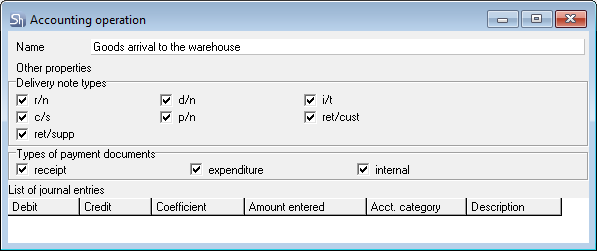To add a new accounting operation:
- Go to Dictionaries > Accounting > Accounting operations
- Use the New accounting operation context menu item or the same option of the Edit main menu item. You can also use a separate New accounting operation item in Dictionaries > Accounting
- In the window that opens, fill in the fields

- Name — specify the operation name that will be used when selecting operations in documents
- Set the flags for delivery notes and payment documents to which the added operation is applicable in the areas of the Delivery note types and Types of payment documents windows
- Enter standard journal entries for the operation in accordance with the rules for the amount distribution
- Save the new accounting operation using the Document > Save document main menu item or the
 button on the toolbar
button on the toolbar
In the table, you should create a list of typical journal entries for this operation. There is no limit on the number of entries for an operation.
To add a new line, press the Insert or ↓ key or use the Add line context menu item.
- Credit — an account from which funds are debited
- Debit — an account to which funds are deposited
- Coefficient — a coefficient with which funds will be transferred between accounts
- Amount entered — specify the document amount — select from the preinstalled list — that will be posted.
List of amounts entered:
| - Compensatory amount Sales Tax
|
| |
- Purchase Sales Tax (receipt)
| |
| |
- Purchase e/t (expenditure)
| |
- Purchase VAT (expenditure)
| |
- Purchase Sales Tax (expenditure)
| |
- Purchase i/t (expenditure)
| |
| |
| |
Acct. category — posting of the document amount may depend on the Accounting categories of delivery note items. If the field is left blank, then the entire amount of the delivery note will be posted. If the field is filled in, then only goods with the selected category will be selected from the delivery note items, and their amount will be posted upon the specified entry.
Acct. category is used when creating an operation if the amounts of different goods must be posted to different accounts.
Description — a brief description of each entry that will be displayed in the reports. The field is optional.
If the entry was created by mistake, then delete the line using the Delete line context menu item or use the Ctrl+Del keyboard shortcut.
